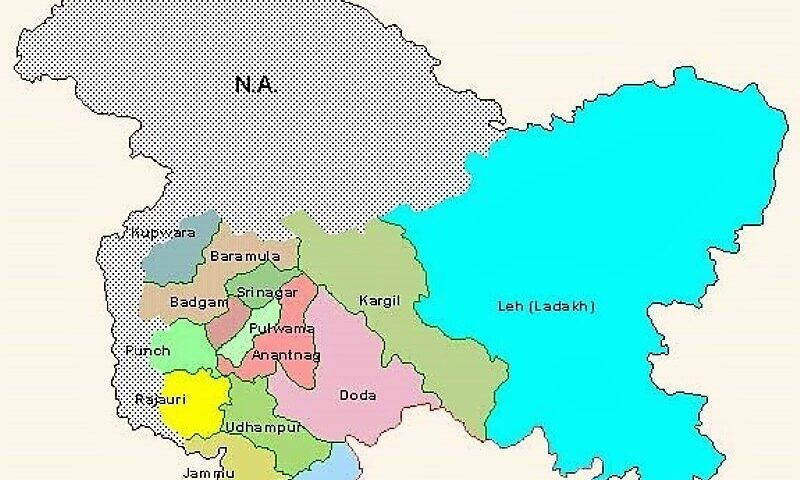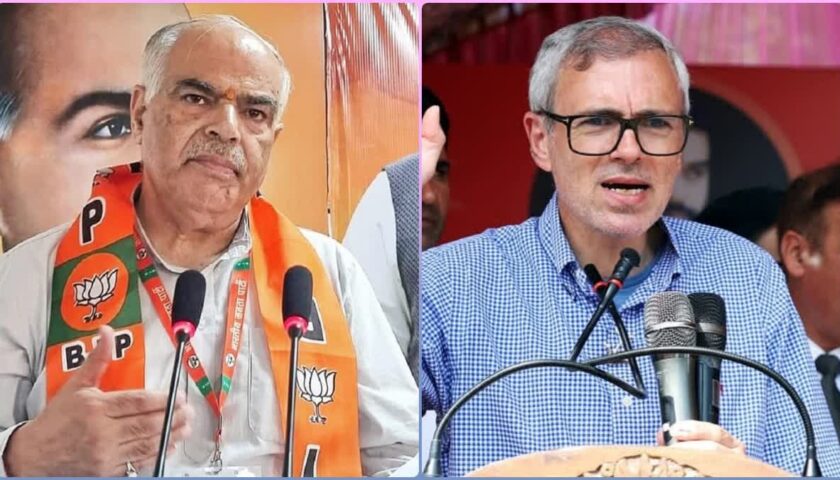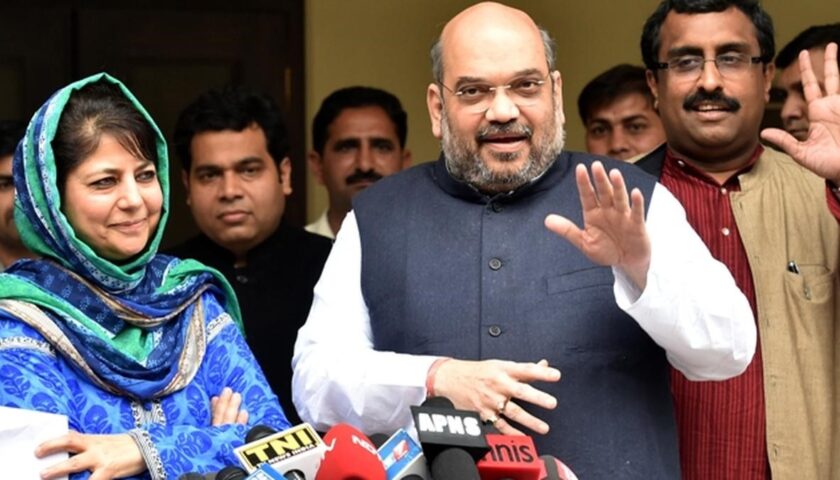From veiled threats to security withdrawals, the People’s Alliance for Change navigates a storm of political sabotage and historical shadows
By: Javid Amin | Srinagar | 07 July 2025
Alliance for Change, or Target for Disruption?
In the volatile landscape of Jammu & Kashmir, political alliances rarely emerge without resistance. And when they do, resistance often comes not just in the form of ideological pushback, but in the weaponization of state power, including the withdrawal of basic protections like security.
On July 6, 2025, Sajad Gani Lone, President of the Jammu & Kashmir Peoples Conference (JKPC) and a sitting MLA from Handwara, sounded the alarm against such tactics. Speaking in Srinagar, Lone accused the administration of using security as a political weapon to intimidate and destabilize the newly-formed People’s Alliance for Change (PAC)—a coalition that seeks to reshape Jammu & Kashmir’s political future.
“We are not here to beg for security. Nor are we here to complain. But we will not be silenced,” Lone said in a resolute tone.
Politicizing Protection: Security Withdrawals Exposed
In a bold public disclosure, Sajad Lone revealed that 80% of the security cover for senior PAC leaders—Hakeem Yaseen and Sheikh Imran—was suddenly withdrawn, just days after the alliance was made public.
Timeline of Events:
-
July 2: The People’s Alliance for Change is formally announced.
-
July 3: Senior leaders meet for strategy formulation.
-
July 5: Administrative orders slash security details of key figures, without official explanation.
-
July 6: Lone goes public with the allegation, calling it a “snap reaction meant to intimidate.”
Lone accused the administration of undermining political rivals by leveraging threat assessments as political tools, rather than objective protocols based on actual ground realities.
“It’s not just administrative overreach; it’s political sabotage masquerading as governance.”
External Threats and Internal Fractures: Who’s Pulling the Strings?
The PAC’s emergence has not just triggered local unease—it has reverberated across the Line of Control.
According to Lone, militant-linked voices from Pakistan have already issued threatening statements, specifically naming leaders associated with the PAC. He cited:
-
Ghulam Mohammad Safi, a veteran from the Hurriyat fold,
-
Naseebuddin, a known Jamaat-e-Islami sympathizer based across the border.
Interestingly, some local voices have also echoed criticism, including:
-
Ghulam Mohammad Bhat, a former senior Jamaat-e-Islami leader, who reportedly condemned the PAC in public—despite private assurances of support, according to Lone.
“I respect Bhat Sahib. I met him with my younger brother Imran. But his public stance contradicts what he told us privately,” Lone revealed, pointing to a growing pattern of duality and pressure.
This blend of external aggression and internal betrayal underscores the difficult terrain PAC is entering: a space where new alliances are seen as existential threats by both state-backed and insurgent actors.
Historical Parallels: When Protection Was Denied and Lives Were Lost
Lone’s warnings are not theoretical—they are rooted in deep personal trauma.
In 2002, his father, Abdul Gani Lone, a moderate voice advocating democratic resolution in Kashmir, was assassinated in broad daylight at a public function in Srinagar. At the time, Abdul Gani Lone had been attempting to create space for civil political dialogue, but was left vulnerable due to systemic neglect and ideological suspicion.
“We have seen what happens when politics becomes a reason to deny security. My father’s death is a chilling reminder,” Lone said.
By invoking this history, Lone seeks to draw a line from past state failures to present political maneuvering—and issue a warning: if security is withdrawn based on ideology, history may tragically repeat itself.
The PAC Vision: Change, Constitution, and Conflict Resolution
Despite the storm surrounding it, the People’s Alliance for Change is not a makeshift coalition. It is a calculated, strategic attempt to fill the political vacuum in Jammu & Kashmir with a democratic, constitutional, and development-oriented agenda.
Member Parties:
-
Jammu & Kashmir Peoples Conference (JKPC) – led by Sajad Lone
-
Justice and Development Front (JDF) – led by Sheikh Imran
-
People’s Democratic Front (PDF) – led by Hakeem Yaseen
Declaration of Change: Key Commitments
-
Restoration of full statehood to Jammu & Kashmir.
-
Legislative autonomy as per pre-August 5, 2019 provisions.
-
Free and fair elections supervised by neutral institutions.
-
Development without discrimination—from Srinagar to far-flung border towns.
-
Ending the culture of coercion and silencing of opposition.
This document, publicly signed by the top PAC leaders, is not merely a declaration—it is a political contract with the people of Jammu & Kashmir.
A Political Alternative, Not an Extremist Retreat
Contrary to what some detractors have suggested, the PAC is not aligned with separatism or soft separatist sentiment. Lone was emphatic:
“We are not here to challenge the Union of India. We are here to challenge the misgovernance and monopolization of Jammu & Kashmir’s democratic space.”
This statement puts PAC in a unique position:
-
Not pro-separatist, like the Hurriyat once was.
-
Not blindly loyalist, like some UT-backed parties.
-
But assertively constitutionalist, seeking to use Indian democracy to revive regional self-respect and administrative autonomy.
In this regard, PAC presents a new centre of political gravity—especially for voters disillusioned with both traditional dynasties and BJP’s centralising tendencies.
Analysis: Why Security Cuts Are a Bigger Threat Than Guns
The revocation of security isn’t merely a safety issue—it’s a symbolic decertification of political legitimacy.
In Kashmir, where assassinations are not uncommon, security withdrawal can:
-
Send chilling signals to potential supporters,
-
Increase vulnerability to extremist elements,
-
Foster a sense of state-backed targeting.
Moreover, it delegitimizes peaceful political activity, essentially rewarding silence and punishing dissent.
If opposition parties are made to operate under threat—while proxies of the ruling party enjoy full state patronage—it damages not just the opposition, but the democratic contract of India itself.
When Protection is Politics: Past Assassinations, Present Patterns
In the political history of Jammu & Kashmir, the denial or manipulation of security cover has not been a rare occurrence—it has often been fatal.
Remembering the Victims:
-
Abdul Gani Lone (2002) – A prominent moderate Hurriyat leader who was gunned down at a rally despite repeated requests for increased protection.
-
Maulvi Mushtaq Ahmad (2004) – Killed in Anantnag weeks after expressing willingness to join the electoral process.
-
Shujaat Bukhari (2018) – Senior journalist and advocate for reconciliation, murdered in Srinagar under inadequate protection.
These assassinations didn’t happen in a vacuum—they occurred in ideologically polarised, security-manipulated climates where moderate or alternative voices were left exposed.
Sajad Lone’s invocation of his father’s death is not mere sentimentality—it is a haunting reminder that politics in Kashmir has often carried a death sentence for those who refuse to tow extremist or statist lines.
Who Gets Security, and Who Doesn’t? The Legal and Moral Matrix
The Union Home Ministry and J&K’s administration determine security cover based on “threat perception”—a technical term that is often vulnerable to political interpretation.
What the Security Grading Looks Like:
-
Z+: Includes elite NSG commandos, for high-value targets (e.g., union ministers).
-
Z: Provided to political leaders facing elevated threats.
-
Y/Y+: Mid-tier protection, often for regional MLAs and opposition leaders.
-
X or No Cover: Denotes minimal or no threat perceived.
However, critics argue that in J&K, these assessments are rarely apolitical.
In 2023–24 alone:
-
Over 75 former MLAs, ministers, and opposition leaders had their security downgraded or withdrawn, many without review.
-
Some junior BJP leaders continue to enjoy upgraded security despite no known threats.
“Security has become the new currency of political loyalty in Kashmir,” said a former police officer on condition of anonymity.
Why the PAC Matters: A Challenge to Monopolized Politics
Since the abrogation of Article 370 in August 2019, J&K has witnessed:
-
The fragmentation of traditional parties (NC, PDP),
-
The rise of state-leaning proxies, like the Apni Party,
-
Dwindling voter turnout and deep public disillusionment.
Enter the People’s Alliance for Change (PAC):
The PAC’s launch represents the first credible alternative alliance not rooted in the dynastic politics of NC or PDP, nor compliant with Delhi’s political framework.
“It’s the first time in five years that an alliance has dared to talk about statehood, constitutional rights, and political accountability—all in the same breath,” says Dr. Junaid Qureshi, a political science professor at Kashmir University.
This explains why the PAC’s emergence has triggered such aggressive responses—from abrupt security cuts to ideological targeting.
The Strategic Implications: Rewriting the Political Map?
The PAC may still be nascent, but its potential to redraw J&K’s electoral map is real.
Constituency Realignment:
-
Hakeem Yaseen has a stronghold in Khansahib, Budgam.
-
Sheikh Imran influences central Srinagar and old-city vote banks.
-
Sajad Lone retains influence in Kupwara, Handwara, and parts of north Kashmir.
Together, their alliance could:
-
Tap into non-dynastic youth votes.
-
Offer credible, post-separatist voices.
-
Mobilise disenfranchised civil society actors.
Their combined reach may not yet rival NC or BJP, but it can certainly fracture their vote shares—especially if PAC gains the moral high ground over security injustice and political persecution.
Civil Society Reacts: From Outrage to Resilience
The sudden downgrading of PAC leaders’ security has also sparked sharp criticism from civil society, journalists, and human rights groups.
Voices from the Ground:
Zubair Dar, Human Rights Advocate (Sopore):
“You cannot punish political mobilisation by stripping protection. This sends the message that the state fears debate more than bullets.”
Fahmida Reshi, Women’s NGO Director (Anantnag):
“If leaders like Hakeem Yaseen or Sheikh Imran are attacked, who will the administration blame? This is not incompetence—it’s premeditated negligence.”
Tanveer Wani, Journalist (Srinagar):
“PAC is not radical. It’s legal. If they’re not allowed to operate safely, who is?”
These voices reflect a growing recognition that the future of Kashmir’s democracy is being negotiated through acts of suppression, not ballots.
International Eyes: Why This Security Saga Has Global Ripples
While India insists that Kashmir is an “internal matter,” the global community still monitors political conditions, especially when security, speech, and democracy intersect.
In 2020–2023, multiple international bodies flagged:
-
The erosion of political liberties in J&K,
-
Arbitrary detentions of opposition figures,
-
Restrictions on freedom of movement and assembly.
Now, if the PAC suffers politically or physically due to targeted administrative action, it risks inviting:
-
Renewed UN human rights attention,
-
Stronger pushback from international civil society groups,
-
Possible diplomatic queries from global democracies.
India can ill afford such scrutiny, especially amid ongoing efforts to project normalcy in Kashmir.
PAC’s Resilience: From Reaction to Mobilization
Despite pressure, the PAC isn’t retreating.
In a press statement on July 6, the alliance pledged to:
-
Continue district-wise outreach,
-
Hold public discussions on statehood and elections,
-
Launch a “Speak Up for Kashmir” campaign that invites public testimonies and grievances.
“Our existence rattles them. That is our strength,” said Sheikh Imran during a door-to-door campaign in old Srinagar on July 7.
Hakeem Yaseen, too, has confirmed that no amount of intimidation will stop the PAC from contesting the next Assembly elections.
Editorial Insight: The Cost of Being the Opposition in Kashmir
What does it say about democracy in Jammu & Kashmir when:
-
Security becomes a punishment for dissent?
-
Protection is withdrawn not after threat assessments, but after press conferences?
-
Political unity is met with covert sabotage and ideological smears?
Sajad Lone’s remarks are not just about PAC. They are about a dangerous precedent where:
-
Only state-approved narratives are allowed safe passage,
-
Opposition is forced to choose between silence and risk,
-
And the death of a leader’s father becomes a template for how to eliminate moderation.
If democracy is defined by how a government treats its critics, then the PAC moment is a litmus test for India’s democratic credentials in its most sensitive region.
PAC’s Media Strategy: Battling the Narrative War
In today’s Kashmir, political messaging doesn’t just travel through speeches and press releases—it navigates a minefield of media distortion, narrative manipulation, and internet controls.
For the PAC, reaching the people without being misrepresented has become a crucial battlefront.
Tactics Deployed:
-
Launch of the “Speak Up for Kashmir” digital campaign featuring short video statements from citizens on core issues like electricity, unemployment, and political accountability.
-
Engagement with regional-language YouTube channels and podcasts to bypass traditional state-influenced media.
-
A dedicated WhatsApp broadcast channel titled “PAC Pulse” to share verified updates, schedules, and declarations.
“Mainstream TV won’t cover us unless we’re arrested or attacked,” said Sheikh Imran at a recent youth gathering. “So we will build our own channels of truth.”
Legal Options: Can Security Cuts Be Challenged in Court?
While the J&K administration has broad discretion over VIP security, arbitrary or punitive reductions can be challenged under:
-
Article 14 (Right to Equality),
-
Article 19 (Freedom of Speech & Assembly),
-
Article 21 (Right to Life and Personal Security).
Legal Precedents:
-
In 2022, the Delhi High Court ruled that security cannot be withdrawn purely on political grounds, setting a useful precedent.
-
A 2023 PIL filed by a PDP leader in the Srinagar Bench of J&K High Court resulted in the restoration of partial cover, after the court noted procedural irregularities.
PAC insiders have confirmed that a legal team has been formed to:
-
Request detailed threat assessments,
-
Seek judicial review of withdrawal orders,
-
Prepare for a possible Supreme Court escalation, if needed.
“Security is not a privilege—it’s protection from a known threat. And threats in Kashmir aren’t hypothetical,” said a PAC legal advisor.
Looking Ahead: The 2025 Assembly Elections and PAC’s Roadmap
With Assembly elections likely to be held by late 2025 or early 2026, PAC has less than a year to mobilize voters, define its agenda, and establish credibility in a field dominated by dynasts and Delhi-backed players.
Key Campaign Planks:
-
Restoration of full statehood with a permanent elected assembly.
-
Legislative safeguards for land, jobs, and cultural autonomy.
-
Accountability for post-370 policies like domicile rules and media restrictions.
-
An end to selective administrative targeting and security revocation.
-
Grassroots economic recovery through tourism, crafts, and tech incubation.
PAC plans to unveil its “Manifesto of Return”—a detailed 30-point charter—in September 2025, aimed at restoring “constitutional dignity and economic dignity.”
“We want to win not just votes, but trust,” says Hakeem Yaseen.
Why the 2025 Election Will Be a Referendum on Dissent
Unlike previous elections post-Article 370 abrogation, the 2025 vote will mark:
-
The first Assembly poll since J&K was downgraded from statehood.
-
The first real test of whether a non-BJP, non-dynastic third front can survive politically.
-
A referendum on Delhi’s Kashmir policy of centralisation, control, and coercion.
PAC will likely face:
-
State-aided opposition from BJP-backed parties like Apni Party and DPAP.
-
Soft sabotage via restrictions on movement, campaign events, and police permissions.
-
Narrative warfare, where attempts will be made to frame the alliance as disruptive or dangerous.
Yet, the PAC also has unique advantages:
-
It taps into the youth’s demand for new leadership.
-
It projects constitutional nationalism, not anti-nationalism.
-
And it represents the middle political spectrum—neither hard separatist nor regime-loyal.
Rebuilding Political Trust in Kashmir: Can PAC Do It?
The biggest challenge facing the PAC is not the BJP, NC, or PDP—it’s disillusionment.
Since 2019, the voter turnout in local and DDC polls has dipped. In cities like Srinagar and Anantnag, abstention has become a form of protest.
Key Reasons for Voter Disengagement:
-
Loss of Article 370 and 35A without consultation,
-
Massive detentions and media censorship,
-
Lack of developmental impact, especially post-pandemic,
-
A sense that “elections change nothing” under LG rule.
PAC’s campaign will have to rebuild the case for the ballot—and convince voters that participation is not surrender, but survival.
“We must prove that democracy still lives here—and that it still listens,” said Sajad Lone at a July 5 strategy meet.
Pluralism Under Pressure: What PAC’s Fight Means for Indian Democracy
Though the PAC is regionally anchored, its struggle has national significance.
In states like:
-
Punjab – federalism is asserted through farm laws and language rights.
-
Tamil Nadu – regional pride resists Hindi imposition.
-
West Bengal – electoral identity shapes opposition resistance.
In J&K, however, asserting regional voice is often mistaken for sedition.
PAC challenges this paradigm by:
-
Speaking in the language of the Constitution,
-
Using ballots instead of boycotts,
-
And opposing central excesses without undermining the Union.
Their real demand is not secession—but a restoration of dignity, rights, and representation.
Final Editorial: Can Kashmir Dare to Choose Again?
As the People’s Alliance for Change trudges ahead under the shadow of security cuts, betrayal, and propaganda, one truth becomes increasingly clear:
The true test of Indian democracy is not how the powerful govern, but how the powerless are allowed to challenge that governance.
PAC may or may not sweep elections.
Its leaders may face more pressure, or worse, violence.
But if their ideas survive, if their presence normalizes opposition, and if their voices reach the masses—that itself is a victory for pluralism.
“We will not be silenced,” Sajad Lone said.
That’s not defiance.
That’s democracy refusing to die quietly.




